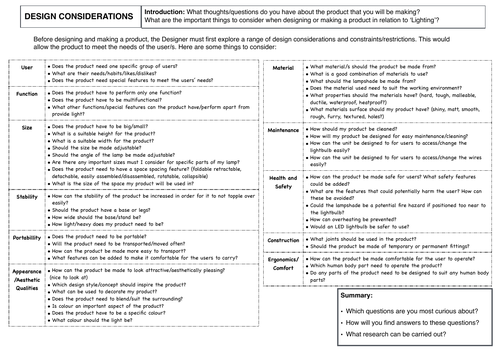







Design and technology projects involve a series of steps to guide the development and realization of innovative solutions. These steps ensure a systematic approach and increase the likelihood of a successful outcome. Here is a breakdown of the key steps involved:
Problem Identification: Begin by clearly defining the problem or need that your project aims to address. This step involves understanding the context, conducting research, and identifying the specific challenge or opportunity.
Research and Analysis: Gather relevant information through research, market analysis, and user studies. This step helps you gain insights into existing technologies, user preferences, industry trends, and potential solutions.
Idea Generation: Engage in brainstorming sessions and idea generation techniques to explore a wide range of concepts and possibilities. Encourage creativity, collaboration, and open-mindedness to generate innovative ideas.
Concept Development: Evaluate and refine the generated ideas based on criteria such as feasibility, market viability, user needs, and technical constraints. Develop detailed concepts and select the most promising ones to move forward.
Design and Prototyping: Translate the selected concepts into tangible designs and create prototypes. Utilize various tools, software, and materials to bring your ideas to life. Prototyping allows for testing, refinement, and validation of the design.
Testing and Evaluation: Conduct rigorous testing of the prototype(s) to assess performance, functionality, safety, and user experience. Gather feedback from potential users and stakeholders to identify areas for improvement.
Iteration and Refinement: Analyze the test results and iterate on the design to address any identified issues or limitations. Refine the design, materials, and manufacturing processes to enhance performance and optimize the solution.
Documentation and Communication: Create comprehensive documentation, including technical drawings, specifications, user manuals, and assembly instructions. Effective communication of the design and its features is essential for collaboration and future reference.
Production and Implementation: Prepare for the production phase by selecting appropriate manufacturing methods, sourcing materials, and ensuring quality control. Coordinate with suppliers, manufacturers, and stakeholders to bring the design to market or implement it in a real-world context.
Evaluation and Reflection: Evaluate the final product or solution against the original project goals and requirements. Assess its success, impact, and user satisfaction. Reflect on the entire project, identifying lessons learned and areas for improvement in future endeavors.
By following these steps, you can navigate the design and technology project effectively, fostering innovation and delivering solutions that meet user needs and make a positive impact.
Something went wrong, please try again later.
This resource hasn't been reviewed yet
To ensure quality for our reviews, only customers who have purchased this resource can review it
Report this resourceto let us know if it violates our terms and conditions.
Our customer service team will review your report and will be in touch.
